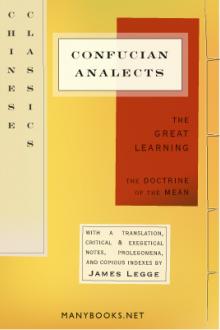Myths and Legends of China, E. Werner [best english novels for beginners TXT] 📗

- Author: E. Werner
Book online «Myths and Legends of China, E. Werner [best english novels for beginners TXT] 📗». Author E. Werner
Southern Origin Improbable
But this latter route would present many difficulties; it would seem to have been put forward merely as ancillary to the theory that the Chinese originated in the Indo-Chinese peninsula. This theory is based upon the assumptions that the ancient Chinese ideograms include representations of tropical animals and plants; that the oldest and purest forms of the language are found in the south; and that the Chinese and the Indo-Chinese groups of languages are both tonal. But all of these facts or alleged facts are as easily or better accounted for by the supposition that the Chinese arrived from the north or north-west in successive waves of migration, the later arrivals pushing the earlier farther and farther toward the south, so that the oldest and purest forms of Chinese would be found just where they are, the tonal languages of the Indo-Chinese peninsula being in that case regarded as the languages of the vanguard of the migration. Also, the ideograms referred to represent animals and plants of the temperate zone rather than of the tropics, but even if it could be shown, which it cannot, that these animals and plants now belong exclusively to the tropics, that would be no proof of the tropical origin of the Chinese, for in the earliest times the climate of North China was Page 15much milder than it is now, and animals such as tigers and elephants existed in the dense jungles which are later found only in more southern latitudes.
Expansion of Races from North to South
The theory of a southern origin (to which a further serious objection will be stated presently) implies a gradual infiltration of Chinese immigrants through South or Mid-China (as above indicated) toward the north, but there is little doubt that the movement of the races has been from north to south and not vice versa. In what are now the provinces of Western Kansu and Ssŭch’uan there lived a people related to the Chinese (as proved by the study of Indo-Chinese comparative philology) who moved into the present territory of Tibet and are known as Tibetans; in what is now the province of Yünnan were the Shan or Ai-lao (modern Laos), who, forced by Mongol invasions, emigrated to the peninsula in the south and became the Siamese; and in Indo-China, not related to the Chinese, were the Annamese, Khmer, Mon, Khasi, Colarains (whose remnants are dispersed over the hill tracts of Central India), and other tribes, extending in prehistoric times into Southern China, but subsequently driven back by the expansion of the Chinese in that direction.
Arrival of the Chinese in China
Taking into consideration all the existing evidence, the objections to all other theories of the origin of the Chinese seem to be greater than any yet raised to the theory that immigrants from the Tarim valley or beyond (i.e. from Elam or Akkadia, either direct or via Eastern Turkestan) struck the banks of the Yellow River in their eastward journey and followed its course until they Page 16reached the localities where we first find them settled, namely, in the region covered by parts of the three modern provinces of Shansi, Shensi, and Honan where their frontiers join. They were then (about 2500 or 3000 B.C.) in a relatively advanced state of civilization. The country east and south of this district was inhabited by aboriginal tribes, with whom the Chinese fought, as they did with the wild animals and the dense vegetation, but with whom they also commingled and intermarried, and among whom they planted colonies as centres from which to spread their civilization.
The K’un-lun Mountains
With reference to the K’un-lun Mountains, designated in Chinese mythology as the abode of the gods—the ancestors of the Chinese race—it should be noted that these are identified not with the range dividing Tibet from Chinese Turkestan, but with the Hindu Kush. That brings us somewhat nearer to Babylon, and the apparent convergence of the two theories, the Central Asian and the Western Asian, would seem to point to a possible solution of the problem. Nü Kua, one of the alleged creators of human beings, and Nü and Kua, the first two human beings (according to a variation of the legend), are placed in the K’un-lun Mountains. That looks hopeful. Unfortunately, the K’un-lun legend is proved to be of Taoist origin. K’un-lun is the central mountain of the world, and 3000 miles in height. There is the fountain of immortality, and thence flow the four great rivers of the world. In other words, it is the Sumêru of Hindu mythology transplanted into Chinese legend, and for our present purpose without historical value. Page 17
It would take up too much space to go into details of this interesting problem of the origin of the Chinese and their civilization, the cultural connexions





Comments (0)